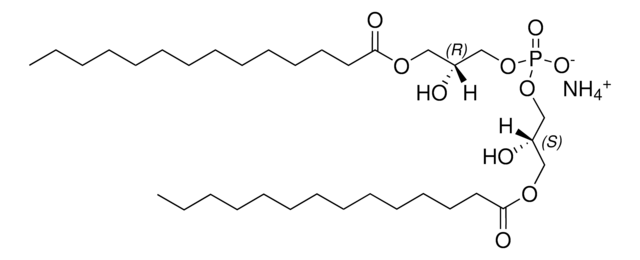810176C
Avanti
18:1-12:0 NBD PA
Avanti Research™ - A Croda Brand 810176C
Synonym(e):
1-oleoyl-2-{12-[(7-nitro-2-1,3-benzoxadiazol-4-yl)amino]dodecanoyl}-sn-glycero-3-phosphate (ammonium salt)
About This Item
Empfohlene Produkte
Assay
>99% (TLC)
Form
liquid
Verpackung
pkg of 1 × 1 mL (810176C-1mg)
Hersteller/Markenname
Avanti Research™ - A Croda Brand 810176C
Konzentration
1 mg/mL (810176C-1mg)
Versandbedingung
dry ice
Lagertemp.
−20°C
Allgemeine Beschreibung
Anwendung
Biochem./physiol. Wirkung
Verpackung
Rechtliche Hinweise
Signalwort
Danger
Gefahreneinstufungen
Acute Tox. 3 Inhalation - Acute Tox. 4 Oral - Aquatic Chronic 3 - Carc. 2 - Eye Irrit. 2 - Repr. 2 - Skin Irrit. 2 - STOT RE 1 - STOT SE 3
Zielorgane
Central nervous system, Liver,Kidney
WGK
WGK 3
Analysenzertifikate (COA)
Suchen Sie nach Analysenzertifikate (COA), indem Sie die Lot-/Chargennummer des Produkts eingeben. Lot- und Chargennummern sind auf dem Produktetikett hinter den Wörtern ‘Lot’ oder ‘Batch’ (Lot oder Charge) zu finden.
Besitzen Sie dieses Produkt bereits?
In der Dokumentenbibliothek finden Sie die Dokumentation zu den Produkten, die Sie kürzlich erworben haben.
Unser Team von Wissenschaftlern verfügt über Erfahrung in allen Forschungsbereichen einschließlich Life Science, Materialwissenschaften, chemischer Synthese, Chromatographie, Analytik und vielen mehr..
Setzen Sie sich mit dem technischen Dienst in Verbindung.

